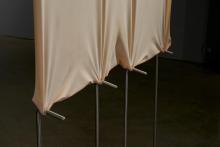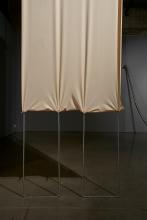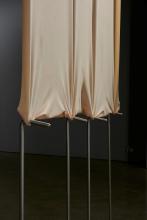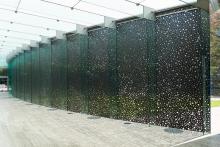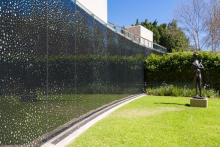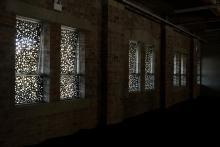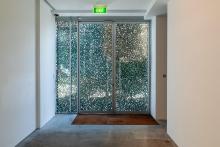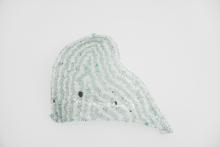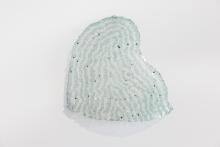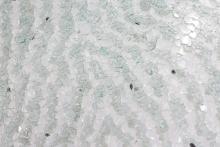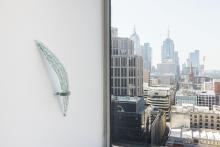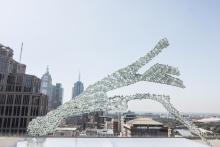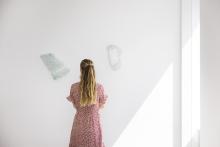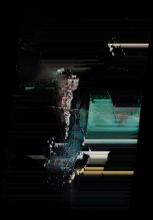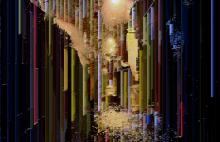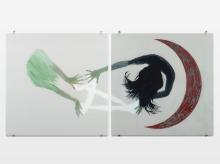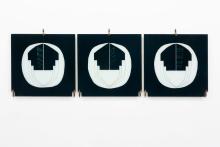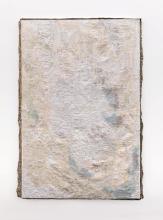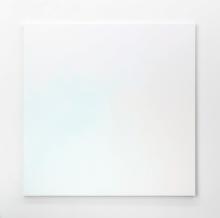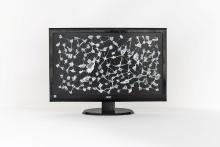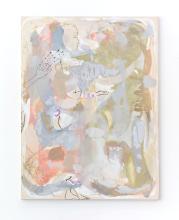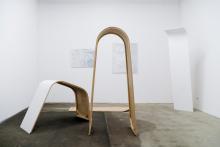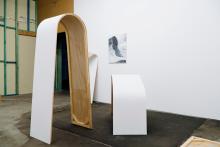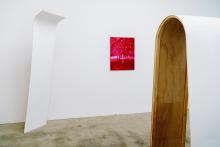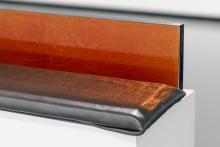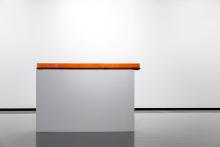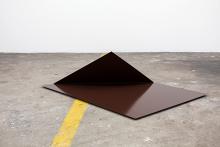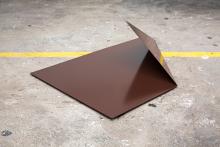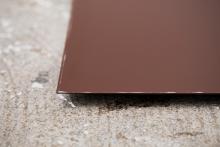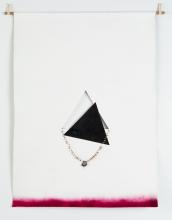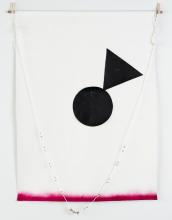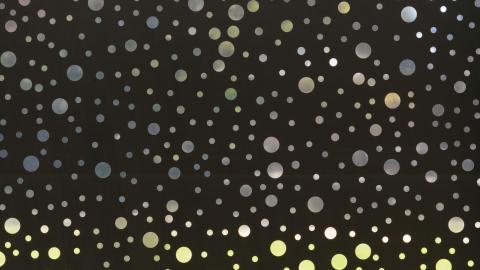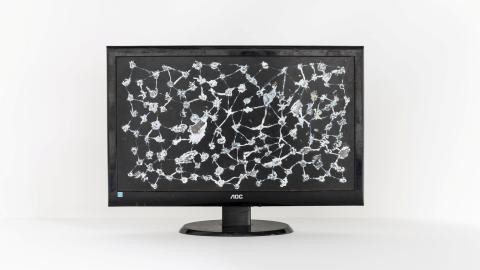WORKS ON LOAN: ‘Living Patterns’
Living Patterns: Contemporary Australian Abstraction
‘Living Patterns’ includes works from QAGOMA’s Australian Art collection, as well as works on loan from artists and private collections around Australia. Discover more about these works on loan, or explore the Collection works featured in the exhibition.
For more installation views, visit ‘Curating abstraction’.
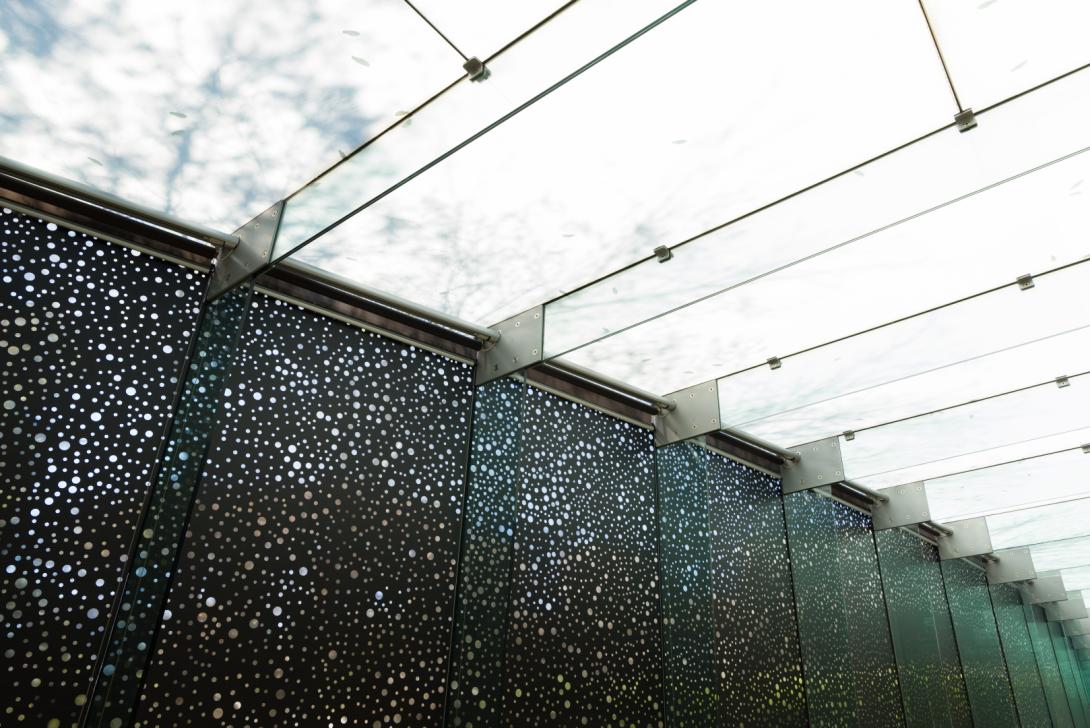
A view of Daniel Boyd’s Untitled (-27.4721524, 153.0181102) 2023, installed for ‘Living Patterns’, QAG, September 2023 / Courtesy: The artist and Roslyn Oxley9 Gallery, Sydney / © Daniel Boyd / Photograph: C Callistemon, QAGOMA
Vivienne Binns
Australia NSW b.1940
Fig and tiles 2019
Acrylic on canvas
130 x 160cm
Courtesy: The artist and Milani Gallery, Brisbane
In 2017, Vivienne Binns visited Spain’s Alhambra, Spain — an Islamic palace chiefly built between 1238 and 1358 and renowned for its elaborate architectural decoration. The palace’s intricate designs have long been a source of inspiration to artists, including William Morris (1834–96), Henri Matisse (1869–1954) and MC Escher (1898–1972). Taking the tiles of Alhambra as a point of inspiration, in Fig and tiles 2019, Binns paints an irregular tessellating pattern that expands infinitely beyond the picture plane. The white silhouette of fig branches — inspired by a tree in the artist’s backyard — points to how nature inspired the arabesque form.
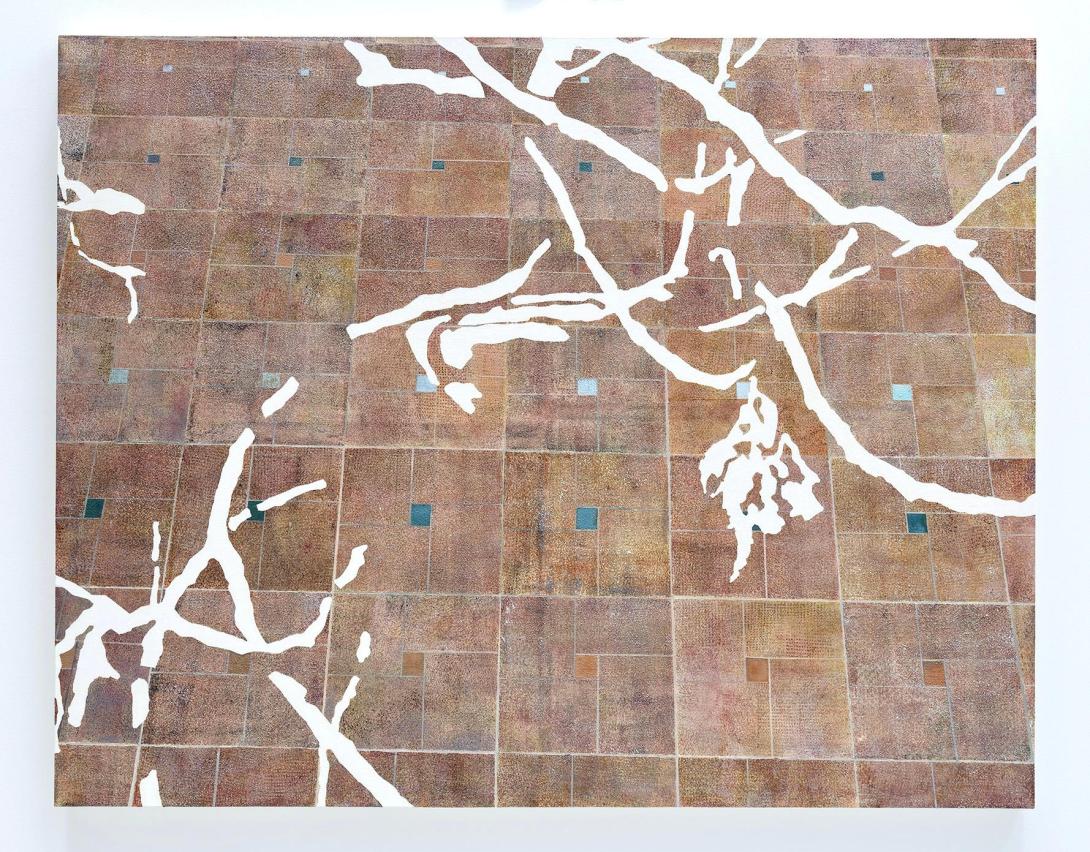
Vivienne Binns / Australia NSW b.1940 / Fig and tiles 2019 / Synthetic polymer paint on canvas / © Vivienne Binns / Photograph: Carl Warner / Courtesy: The artist and Milani Gallery, Brisbane
Kate Bohunnis
Australia SA b.1990
an active accumulation (tense) 2020/23
Latex, stainless steel
700 x 120 x 50cm
Courtesy: The artist and STATION, Melbourne/Sydney
Kate Bohunnis’s sculptures often feature latex, silicone and fabric hanging and stretched from stainless steel armatures; this stiff, shiny medium stands in stark contrast with soft and pliable materials. In an active accumulation (tense) 2020/23, a long piece of pink latex extends from the floor to the ceiling of the gallery. The metal hooks at either end place this ‘skin’ under tension, evoking images ranging from slaughterhouses to erotic piercing. Latex has a strong association with the body, from medical gloves to condoms and fetish wear. Bohunnis draws on these points of reference to summon thoughts of pleasure and pain.
Views of Kate Bohunnis’s an active accumulation (tense) 2020, installed for ‘Material Girls’ at Praxis ARTSPACE, Adelaide, 2020 / © Kate Bohunnis / Photographs: Sam Roberts / Courtesy: The artist and STATION, Melbourne/Sydney
Views of Daniel Boyd’s Untitled (-27.4721524, 153.0181102) 2023, installed at QAG’s Gibson Entrance, September 2023 / Courtesy: The artist and Roslyn Oxley9 Gallery, Sydney / © Daniel Boyd / Photographs: C Callistemon, QAGOMA
Installation views of Kudjla and Gangalu artist Daniel Boyd’s works from Carriageworks, Sydney, 2019 / Photograph: Michael Waite; Fondation Boghossian, Brussels, 2017 / Photograph: Lola Pertsowsky; and Institute of Modern Art, Brisbane, 2022 / Photograph: Joe Ruckli / © Daniel Boyd / Images courtesy: Roslyn Oxley9 Gallery, Sydney
Lauren Burrow
Australia NT/VIC b.1992
Slow plosion I–IX 2022
Tempered glass, perspex, adhesive, nail polish
Nine pieces; dimensions vary
Courtesy: The artist
Lauren Burrow’s ‘Slow plosion’ series is created from broken pieces of glass that refract light in all directions, like sunlight dancing across ripples in water. Tempered glass, often used for car windows, is designed to shatter into small pieces to reduce injury from large shards. The fragments in these artworks are thus suggestive of a strong impact, reiterated by the word fragment ‘plosion’ in the artwork’s title. The shapes of Slow plosion I–IX are inspired by sections of the Birrarung (also known as the Yarra River, Victoria), before and after it was blasted with explosives in the late 1800s to facilitate shipping and industry. These jewel-like sculptures subtly evoke the violence of human impact on the natural landscape.
Views of Lauren Burrow’s ‘Slow Plosion’ 2022 works installed in foryouandyourcustomers, Melbourne, March 2022 / Courtesy and © Lauren Burrow / Photographs: Fresh Photography
Christian Capurro
Australia WA/VIC b.1968
Mimic's Turn (enclasticine 572) 2020–21
Clarence Street Instrument (enclasticine 429) 2019–21
Howells (enclasticine 515) 2020–21
Inkjet prints on Canson Platine Photographic Rag paper
Three pieces; dimensions vary
Courtesy: The artist and Milani Gallery, Brisbane
Works from Christian Capurro’s ‘enclasticine’ series 2017–21 / © Christian Capurro / Courtesy: The artist and Milani Gallery, Brisbane
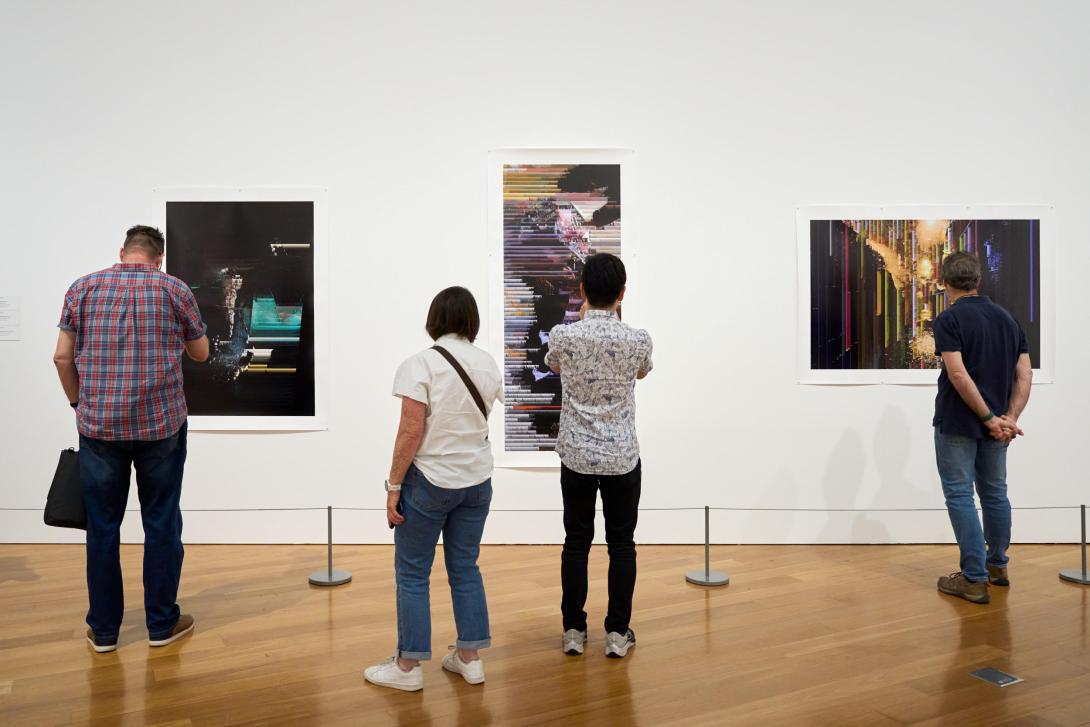
Works from Christian Capurro’s ‘enclasticine’ series 2017–21 installed for ‘Living Patterns’, QAG, September 2023 / © Christian Capurro / Photograph: C Sanders, QAGOMA
Gallery view: Works by Mikala Dwyer, Clare Milledge, Teelah George, Hilarie Mais, Gemma Smith, Simon Wilson Pitjara and John Spiteri / © The artists
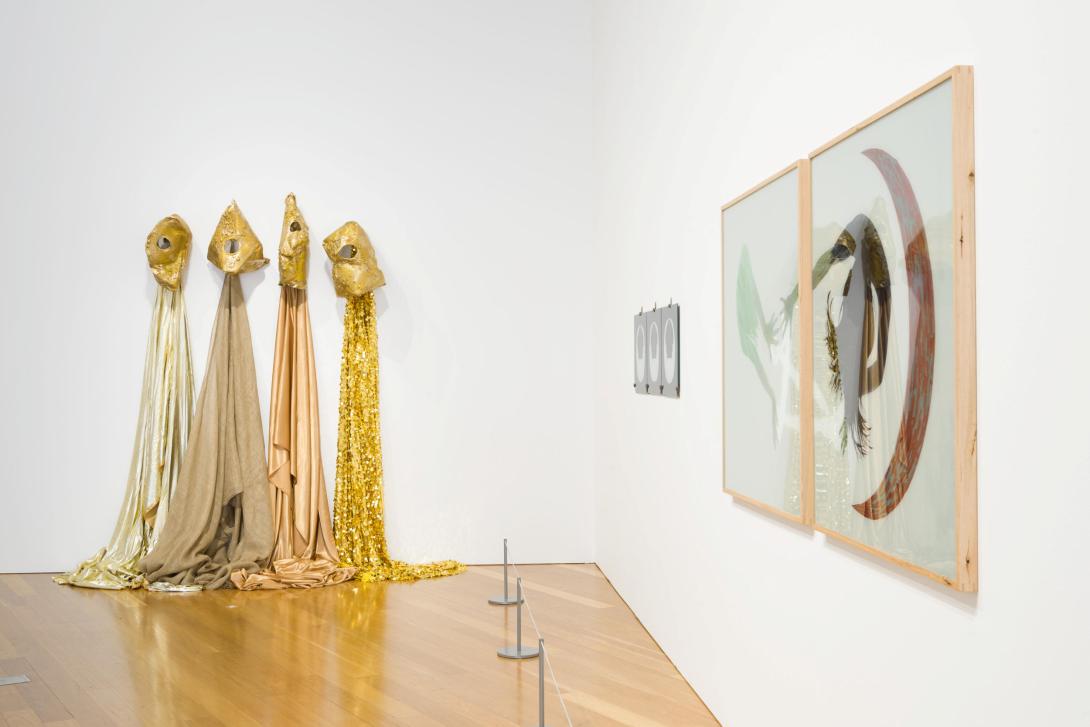
Installation view of ‘Living Patterns’, featuring (l–r) Mikala Dwyer’s The Collapzars 2012 and Clare Millege’s Sruth 2021, QAG, October 2023 / © The artists / Photograph: C Callistemon, QAGOMA
Tyza Hart
Australia QLD b.1990
Hands and feet on the ground 2018
Lying on art gallery floors 2018
Nowhere to nowhere 2018
Receiving an award in high school 2018
Untitled reach 2018
Acrylic paint, plywood, pine, wire and steel
Five pieces; dimensions vary
Courtesy: The artist and Darren Knight Gallery, Sydney
Tyza Hart is known for their self-portraits, rendered in oil paint, that take perceptions of personhood as their subject. In this series of sculptures, however, they leave figuration behind — along with its art historical lineage that is loaded with gendered images. As an alternative to simply gazing upon an inanimate painting, viewers are instead positioned to navigate a physical relationship to these human-scaled sculptures. The blank, primed painting boards jump off the wall to lean and flop as if imbued with a light touch of animism. The repetition of forms evokes a collective or even multiple selves. Here abstraction enables discussions about the body and selfhood that are liberated from the images of old, allowing artists like Hart to envision forms of the self through new metaphors.
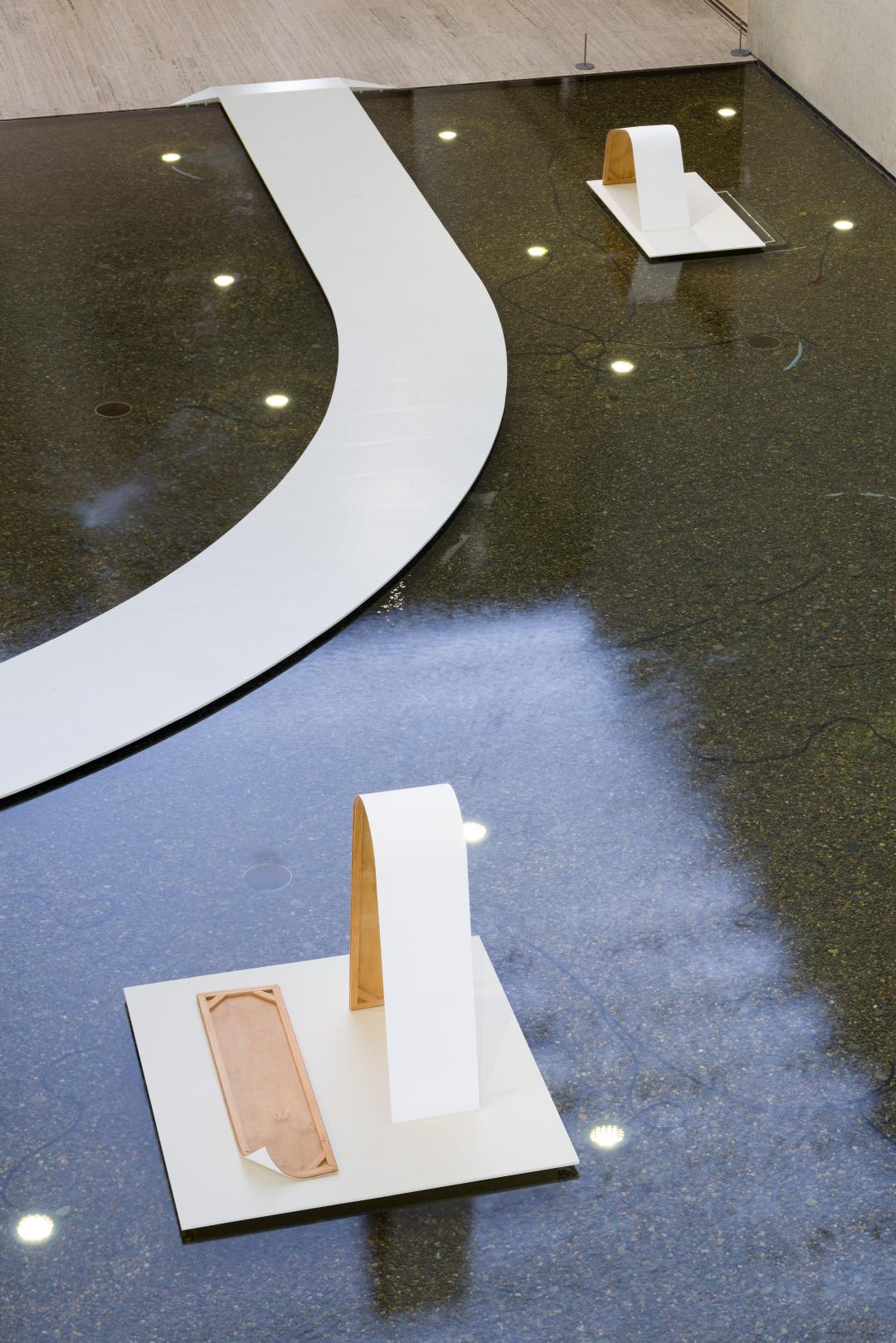
Works by Tyza Hart installed on the Watermall for ‘Living Patterns’, QAG, September 2023 / © Tyza Hart / Photograph: C Callistemon, QAGOMA
Tyza Hart’s work installed for ‘Assuming a Surface’, Outer Space, Brisbane, 2018 / © Tyza Hart / Photographs: Charlie Hillhouse / Courtesy: The artist and Darren Knight Gallery, Sydney
d harding’s Moonda and The Shame Fella 2018, installed for ‘D Harding: Through a lens of visitation’, Monash University Museum of Art, Melbourne, 2021 / © d harding / Photographs: Andrew Curtis / Courtesy: The artist, Brisbane and Milani Gallery, Brisbane
Carbiene McDonald Tjangala
Pintupi and Pitjantjatjara peoples
Australia NT b.1961
Four dreaming 2022
Synthetic polymer paint on linen
183 x 152cm
Courtesy: The Hassall Collection, Warrang/Sydney
Carbiene McDonald Tjangala uses an innovative technique: dividing his composition into rectangles by painting gridlines of assorted size across the canvas, he laboriously paints the individual rectangles in circular motions. By using varying thicknesses of paint and delicate shifts in colour — in addition to the varying sizes of the squares in the grids — McDonald Tjangala creates a sense of dynamism across the canvas.
Four dreaming 2022 references the artist’s tjukurrpa (Dreaming), which was inherited from his father and relates to waterholes located between Kaltukatjara (Docker River) and Kata Tjuta (The Olgas) south-west of Alice Springs in the Northern Territory.
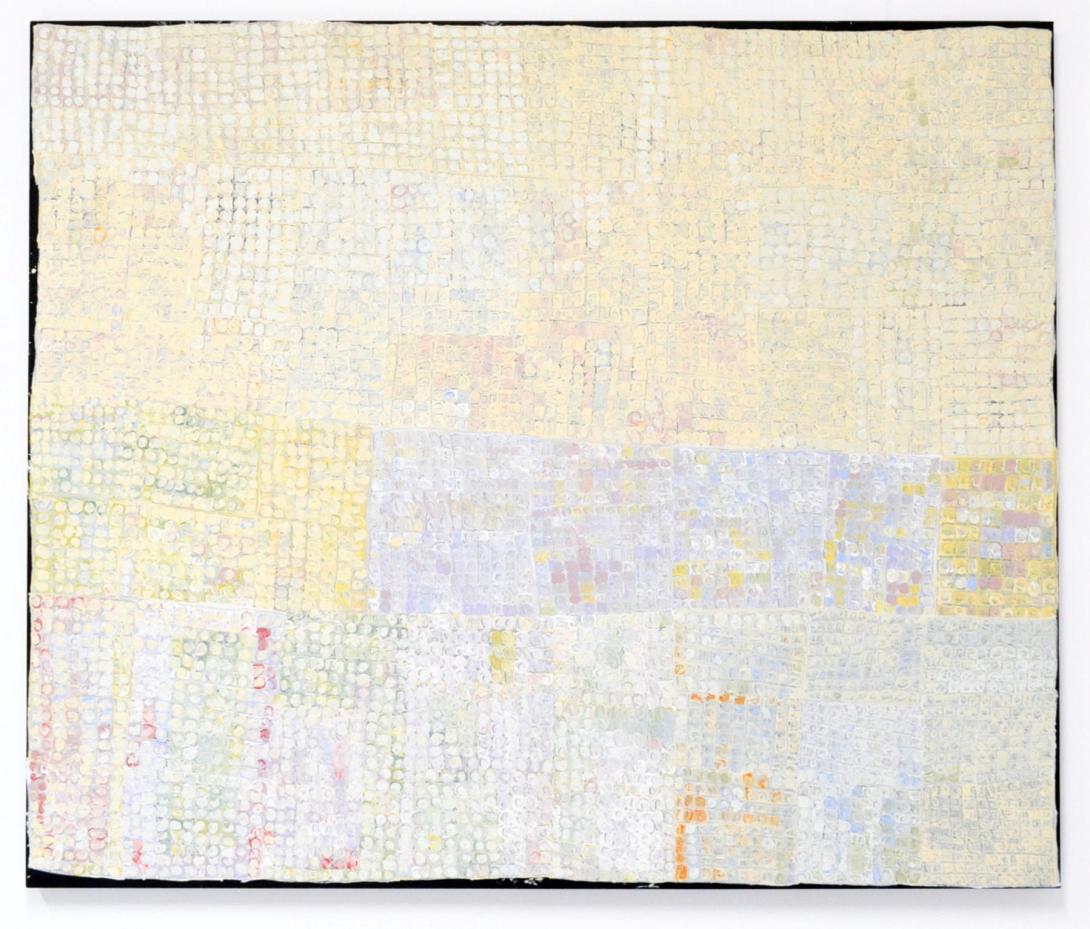
Carbiene McDonald Tjangala / Pintupi/Pitjantjatjara peoples / Australia NT b.1961 / Four dreaming 2022 / Synthetic polymer paint on linen / Collection: Hassall Collection, Sydney / © Carbiene McDonald Tjangala/Copyright Agency / Image courtesy: Aboriginal & Pacific Art, Sydney
Installation views of Spence Messih's You move (on the other side of) 2017 (installation views) / © Spence Messih / Photographs: Document Photography / Courtesy: The artist and Alaska Project
Salote Tawale
Fiji/Australia NSW b.1976
You/me #1 2019
Us 2019
You/me #2 2019
Acrylic on calico, acrylic on linen, wooden dowel, shells, nylon, nylon embroidery thread
220 x 180 x 5 cm (each)
Purchased 2019
Collection: Artbank, Sydney
Salote Tawale is known for her do-it-yourself attitude to painting, sculpture and video. You/me #1, Us and You/me #2, all 2019, riff on masi barkcloth, which is made by Fijian women from the inner bark of the mulberry tree (Broussentia papyrifera). The resulting material is decorated with designs in natural dyes and used in a variety of ways, including as garments, bedding and ceremonial gifts. In Tawale’s three paintings, barkcloth is substituted for easily accessible calico and natural dyes for synthetic paint, with the intricate geometric designs found in masi reduced to the basic design ingredients of circles and triangles. For the artist, maintaining a connection to her Fijian heritage while living in the diaspora necessitates an agile approach.
Views of Salote Tawale’s You/me #1, Us and You/me #2 2019 / Purchased 2019 / Collection: Artbank, Sydney / © Salote Tawale / Photograph: Jennifer Leahy / Image courtesy: Artbank, Sydney
Hossein Valamanesh
Iran/Australia SA 1949–2022
Architecture of the sky no.1 2014
Lotus leaves on paper on plywood
120 x 120cm
Proposed for the QAGOMA Collection
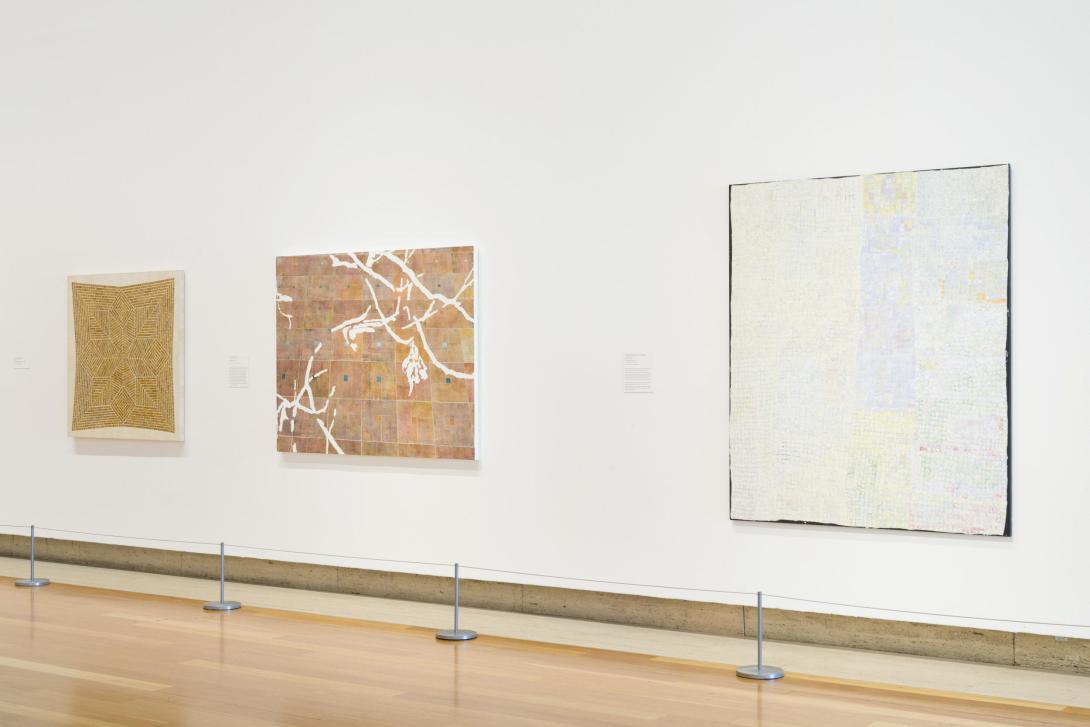
Installation view of ‘Living Patterns’, featuring works by (l–r) Hossein Valamanesh, Vivienne Binns and Carbiene McDonald Tjangala, QAG, September 2023 / © The artists / Photograph: C Callistemon, QAGOMA
Constanze Zikos
Australia VIC b.1962
U Robe 2021
Vinyl on wood composite board
161 x 222 cm
Courtesy: The artist and Murray White Room, Melbourne
While white marble examples of ancient Greek architecture and art can be found in many museums around the world, Constanze Zikos’s use of lurid colours for the meander and geometric patterns in U robe 2021 reminds us that these artefacts were once painted in a riotous array of colours. Greek art is revered for its refinement, yet the flamboyant palette that Zikos deploys is more commonly associated with kitsch. This is further heighted by the artist’s use of cheaply produced vinyl and wood veneer to create an artwork with a shallow surface. Zikos’s engagement with kitsch raises questions of authenticity — not just in relation to materials, but also our perceptions of culture.
